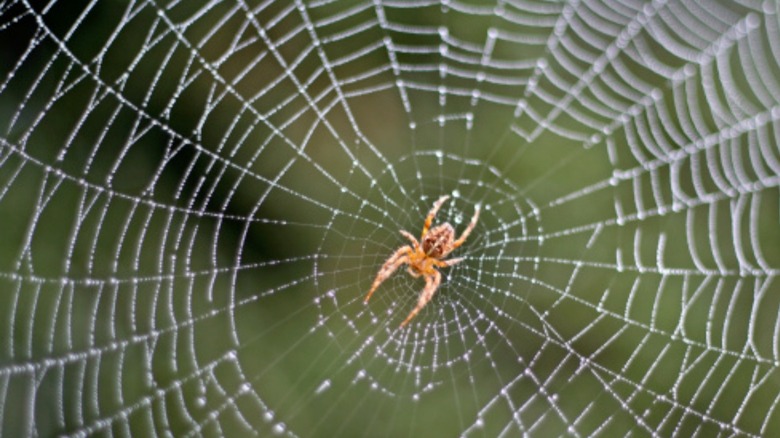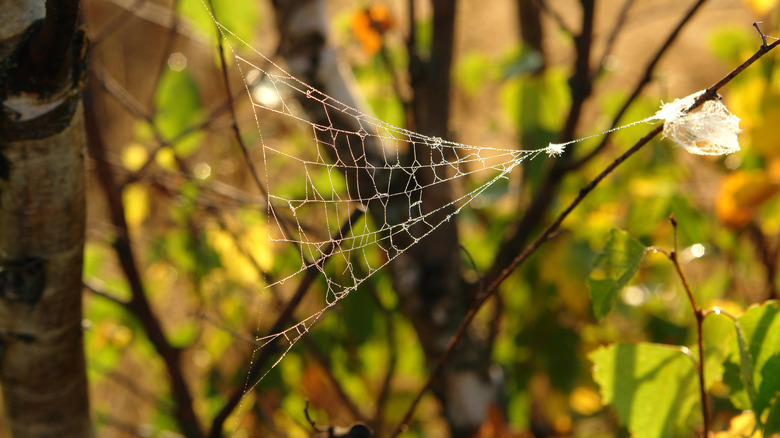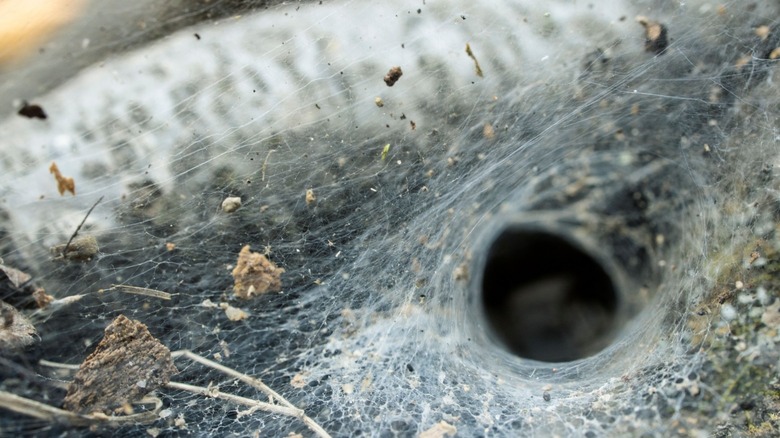Types Of Spider Webs You'll See In The Garden And How To Identify Who They Belong To
Spiders are really quite fascinating creatures, albeit borderline creepy. To imagine one spinning such a large and intricate web in a matter of just a few hours is nothing short of amazing. They are both predator and prey, and they play a vital role in our ecosystem. When you're outdoors and in your yard and garden, you will likely see their webs now and then. By being able to identify the basic types of web structures and what kind of spiders make them, you can avoid chance encounters with poisonous varieties.
There are five main types of spider webs you may encounter outdoors, such as orb-shaped, funnel-shaped, triangle-shaped, sheet webs, and mesh webs. Cobwebs are typically only found indoors, but their outdoor equivalent is considered to be mesh webs. Each of these web constructs have distinctive characteristics. Specific spider families make specific types of webs, so it's important to know about both. Furthermore, some spiders don't spin webs at all. What's worse, those are the spiders most likely to scare the daylights out of you, because jumping spiders are among them. Unfortunately, so are brown recluses, wolf spiders, and hunting spiders that do not use webs to catch prey.
Orbs and triangles
Spiders that spin fancy round webs belong to the Araneidae family, and this group of spiders is quite impressive. They spin their elaborate spoked-wheel-type web in its entirety in one evening, removing it at the end of the night and rebuilding it again every night thereafter. These spiders love to spin their webs across twigs, leaves, and branches, and can span several feet in width. Some of the strands of the web are sticky, while some are not, instead serving the purpose of navigation for the spider. The main thing is, spiders in this family generally don't bite, and if they do, it shouldn't cause much harm (via Thought Co.).
Triangle-shaped webs can be compared visually to a slice of pie, and are not sticky but fuzzy. These spiders do not have venom, but the unique aspect of their triangular web is they use it like a slingshot to shoot through the air and grab their prey. There's basically one strand of silk that the spider holds it all together with. After weaving the triangle, the spider pulls that thread and moves backwards on it, building up tension as it goes. It can stay in that position for hours, and when the time is right, catapults itself, web and all, and with such force and velocity that scientists can't figure out how it doesn't squash itself.
Funnel weavers, sheet, and mesh webs
Some species of funnel-weaving spiders are among the most venomous and deadly in the world. Luckily, the ones found in the U.S. are typically harmless (via University of Wisconsin). Often you'll see their webs in the grass, in bushes, and in woodpiles. The webs are designed as a sort of horizontal trap, and when an insect walks on the silk, the spider darts out and bites it to paralyze it, grabs it, and drags it through the funnel to safely eat it in privacy.
Sheet webs are often seen laying across the top of the lawn, typically woven by the Linyphiidae family of spiders. These webs are interesting because they have vertical "tripwires" that are designed to knock insects down and into the thick layers of silk that make up this web. The spider lays in wait, upside down underneath the web, ready to bite into whatever falls above it. Mesh webs, as aforementioned, are like the outdoor version of cobwebs. These webs can be found almost anywhere, especially under leaves and rocks. They're typically crafted by the Dictynidae family of spiders and they generally don't bite humans (via Picture Insect). Spiders are typically regarded as beneficial in the garden. They prey on insects harmful to many plants, and help to minimize the spread of plant diseases.


